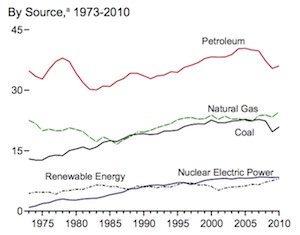Front Porch Blog
For the first time since the late 90s, energy produced by renewable sources (biomass, hydroelectric, wind, geothermal and solar) has surpassed the amount of energy produced by nuclear plants in the U.S., according to the most recent Monthly Energy Review from the U.S. Energy Information Administration (EIA). Link to the report. 
The report shows that 6.944 quadrillion Btu’s (quads) were generated by renewable sources during the first nine months of 2011, 12.5% more than the 6.173 quads generated by nuclear power plants during this time. Of the 6.944 quads produced by renewable sources, 47.85% comes from biomass (wood, organic waste, and biofuels), 36% comes from hydroelectric, 12% from wind, 2.4% from geothermal and 1.25% from solar (photovoltaic). Although as Amitabh Pal comments in an article for The Progressive, “the ‘renewable’ category here is a bit of a catch-all, since it includes sources that are somewhat dubious from a clean energy standpoint, such as biofuels.”
Nonetheless, this marks a hopeful turning point in our country’s quest for a clean energy future. Growth in the renewable energy sector continues unabated, in spite of global recession. Looking at another EIA report, Ken Bossong notes that, “compared to the first three quarters of 2010, solar-generated electricity expanded in 2011 by 46.5%; wind by 27.1%, geothermal by 9.4%, and biomass by 1.3%.” Nuclear generation, by comparison, decreased by 2.8% during the same time period.
The number of operable nuclear facilities in the U.S. increased from 42 in 1973 to a maximum of 112 in 1990. Since 1998, the count has held steady at 104. “Operable” is a liberal term, “in that it does not exclude units retaining full-power licenses during long, non-routine shutdowns that for a time [render] them unable to generate electricity,” opines the EIA. For example, the five Tennessee Valley Authority (TVA) nuclear units active in 1985 (Browns Ferry 1,2 and 3; Sequoyah 1 and 2) were shut down under a regulatory forced outage, and restarted in 1991, 1995, 1988, and 1988, respectively. However, during this time each was considered “operable” by the EIA.
While TVA is attempting to reanimate a “zombie” plant , the Bellafonte 1 reactor, and to finalize the Watts Bar 2 reactor, these plants would only replace soon-to-retire nuclear plants, rather than leading to a net expansion of the U.S. nuclear industry (WaPo).
PREVIOUS
NEXT
Related News

Leave a comment
Your email address will not be published. Required fields are marked *

Thanks for finally writing about > U.S. Renewable Energy
Production Surpasses Nuclear in 2011